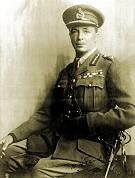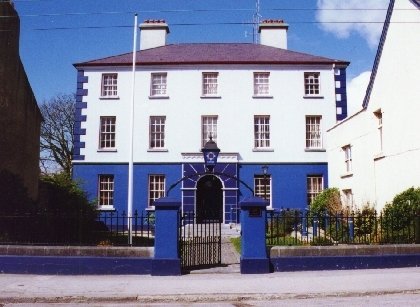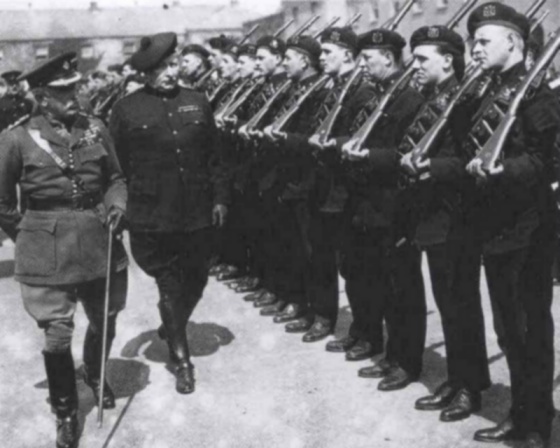|
 |
Major
General
Sir
Henry Hugh Tudor
(1870-1965)
K.C.B.,
C.B., C.M.G. |
 |
The son of a sub-dean
of Exeter Cathedral, Henry Hugh Tudor was born at Newton Abbey, Devonshire,
England in 1870. On 25 July 1893, he attained the rank of lieutenant in
the Royal Artillery. When the Anglo-Boer War started in 1899 he was serving with M Battery Royal Field Artillery
at Woolwich . According to the 'Army List' for April 1902 he was involved
in the advance on Kimberley and was wounded at Magersfontein. While recovering
in hospital, he received a message in December 1899 from Winston Spencer
Churchill (who was then a war correspondent) wishing him a quick recovery
and "all the luck of war". Churchill later sent him autographed first edition
copies of each book written that he wrote. Tudor spent the remainder of
the War serving on the Staff and by the end of the War he had reached the
rank of Captain.
During World War I,
he served in both Egypt and India, but it was as commanding officer of
the 9th Scottish Division in France that he became renowned as a fine military
leader. Tudor claimed to be the one who developed the creeping barrage
and the box barrage to isolate fields of battle. The Box barrage was smoke
and heavy artillery bombardment on both sides and in front so the attacking
area was isolated, preventing enfilade fire and bringing up reinforcements.
The creeping and box barrages were used in the later stages of the war.
He also became renowned by the British War Office for his use of smoke
screens in cloak his troop movements, and in the process save the lives
of thousands of his men. In March 1917 there were massive Allied retreats
throughout the western front, but Tudor's men stood fast causing Churchill
to comment that "Tudor was like an iron peg in the frozen ground". Further
details of his distinguished WW1 service can be found in S. Gillon's
"The K.O.S.B. in the Great War" (London 1930), under Tudor, Major-Gen.
H. H. To read more about World War 1, see Tom Morgan's Hellfire
Corner Great War Pages.
Following the executions
of the leaders of the 1916 Easter Rising and the 1918 threat of conscription
there was widespread civil unrest and resistance (both armed and passive)
to British rule in Ireland. The Sinn Féin MP's refused to go to
Westminster and set up their own government called "Dáil Éireann".
The Irish Volunteers were waging an intensive guerrilla war against the
British establishment which many claim was sparked off by the ambush of
two RIC officers at Soloheadbeg, Co. Tipperary, on 21 January 1919.
The Royal Irish Constabulary
which had earned the title of "Royal" from Queen Victoria for their part
in quashing the Fenian Rising of 1867 were unable to contain the latest
insurrection. Policemen (many of whom were Irish born Catholics) were being
killed and injured either in their barracks or while on patrol. Richard
Bennett in his book "The Black and Tans" (London) 1959, p. 47, states that
by the end of May 1920, 351 evacuated barracks were destroyed, 105 damaged,
15 occupied barracks were destroyed and 25 damaged, 19 Coastguard stations
and lighthouses were raided for explosives and signalling equipment, 66
policemen and 5 soldiers were killed with 79 policemen and 2 soldiers wounded.
DeValera and other members of the Sinn Féin government urged the
shunning of the RIC and their families by their neighbours and friends
and that the RIC should be treated as agents of a foreign power. As a result
of the violence and shunning there was widespread resignations from the
RIC.
MR BONAR LAW INSPECTS RIC ( R.I.C. )
|
British Prime Minister Lloyd George, accompanied
by Sir Hamar Greenwood and Mr. Bonar Law,
inspecting R.I.C. and Auxiliaries in London |
Lloyd George's Westminster
Government created a temporary police force to supplement and assist the
RIC in their duties in the alarming situation which was developing in Ireland.
The members of the new force were appointed as Temporary Constables. The
Temporary Constables were recruited from England, Scotland and Wales, with
possibly a third of the new recruits from Ireland. They were rank and file
World War One veterans, who were then unemployed. The Temporary Constables
were employed on a contract basis of between £3 10s to £4 15s
a week and arrived in Ireland in March 1920.
The Temporary Constables,
whose duty was to hunt the IRA wore a dark bottle green and khaki uniform,
got their nicknamed from the famous "Black and Tans" pack of hounds near
Upperchurch in County Tipperary. It was due to a shortage of the dark bottle
green RIC uniforms that the Temporary Constables were kited out in a uniform,
which was half black (the dark bottle green police) and half khaki (army).

| |
Listowel Garda Station formerly Listowel RIC Barracks |
In
May 1920, Lloyd George's Westminster Government appointed him as police advisor to the Viceroy.
Later in November 1920, T.J. Smith retired as Inspector General of RIC and was replaced by Tudor who also took the title of Chief of Police, commanding both the Royal Irish Constabulary (RIC) and the Dublin Metropolitan Police (DMP).
Between 1 May 1920 and 31 July 1920 there had been over 500
resignations from the RIC. It is claimed that the resignations increased
after the Listowel Police Mutiny of 17 June 1920 (at which Tudor was present),
when the police stationed in Listowel RIC Barrack's (now Listowel Garda
Station) refused to hand over their barracks to the army. The Republicans
created their own Republican Arbitration Courts and Criminal Courts with
their own Republican Police to patrol the country and bring offenders to
their courts. Three offenders who had been banished by a Republican Land
Court to an Island off the west coast for 3 weeks refused to be rescued
by the RIC saying that they were loyal citizens of the Irish Republic.
In June 1920, the Irish Bulletin claimed that the Republican Police had
arrested 84 criminals in 24 counties within 13 days.
EARLDOM FOR LORD |
Pathé Newsreel showing the retiring Viceroy Lord French
making a farewell inspection of RIC and Auxiliaries at
the Depot. Henry Hugh Tudor is in his entourage. |
The British Government
were becoming more alarmed and a second temporary police force was created
on 27 July 1920. This time the recruits were unemployed W.W.I veterans
who had been officers during the war (however, two members of the new force
who had not been officers during W.W.I managed to join this new force).
They were given the rank of Temporary Cadets. The Cadets who could wear
either the RIC uniform or army officers uniforms with dark Glengarry caps,
were also employed on a contract basis but were paid £1 a day for
their services. They became known as "The Auxiliaries" or "The Auxies"
because they were sent as reinforcements to the RIC and Temporary Constables.
Together these new forces became known as "Tudor's Toughs" after their
commanding officer.
 |
Lord French reviews a Parade of Auxiliaries at the Depot
Tudor was also present, see the above newsreel. |
Many of these new cadets
had distinguished themselves on the battlefields of "The Great War". Two
of the new Cadets, George Onions and James Leach, had been awarded had
been awarded the Victoria Cross for their heroic actions during W.W.I.
However, the new forces were trained as soldiers and unlike the Royal Irish
Constabulary were not trained as police officers. Like the German soldiers
of WW1 who invaded Belgium they were not trained in guerrilla warfare.
Every civilian was a potential sniper and reprisals were widespread. The
IRA's Flying Columns were active in nearly every part of the country. Perhaps
it was the frustration that they encountered in trying to capture and fight
the hidden enemy that they ended up as looters, arsonists and murderers.
Both sides engaged in bloody reprisals, the most notable was perhaps "Bloody
Sunday," 21 November, 1920. After 11 English intelligence agents were assassinated
and the Black and Tans fired upon unarmed spectators and players who were
playing Gaelic football in Croke Park, Dublin, resulting in 12 dead and
60 wounded.
WAR OF REPRISALS
|
Pathé Newsreel showing house and shops in
Trim smoldering after an Auxiliary reprisal raid |
Many towns and villages
were burned and looted by Tudor's men. Two famous incidents which later
involved Tudor were occurred on 9th February 1921. On that date a contingent
of Auxiliaries went on the rampage in a Unionist's spirit grocer shop in
Trim, County Meath, (causing an estimated £325 damage), while in
County Dublin near Drumcondra two young Irish prisoners were shot dead
in a field by an auxiliary commander named King. General Crozier went to
investigate the Trim incident and dismissed 21 auxiliary cadets and held
5 more to be tried for their part in the raid (two of whom later broke
out and robbed a publican). He returned to investigate the Drumcondra shootings
but later claimed, the evidence was rigged. His power to dismiss auxiliaries
was taken away by Tudor in November 1920. 5 of the Trim cadets were later
convicted and 19 reinstated. Crozier resigned on 25 February 1921 and the
London press filled with accounts of Tudor's treatment of him and "Black
and Tans" atrocities. In April 1921, 3 of the Drumcondra cadets were tried
but the case was dismissed due to lack of evidence.
KEEPING THEIR HAND IN
| |
Pathé Newsreel showing Auxiliaries at revolver practice. |
Tudor threatened to
sue one author for libel, for repeating Crozier's charges until he issued
a public apology and had pages removed. Later, Mrs. Asquith, wife of the
British Prime Minister later commented to Crozier;- "They tell me that
you are as much a murderer as any of them, only you like things done in
an orderly manner, and at Trim they were disorderly."
The IRA believed that
Tudor was fully behind the atrocities carried out by the "Black and Tans"
and "the Auxiliaries" and set out to assassinate him. However, the IRA
agents sent to shoot him mistakenly shot his Aide-de-Camp.
TIME TO REMEMBER
THE PLUNGE INTO PEACE (1920)
- reel 4
| |
Pathé Newsreel showing Ireland in 1920 |
Peace eventually came
with the Truce of July 1921 and Tudors Royal Irish Constabulary was disbanded
following the Anglo-Irish Treaty in 1922 and a new police force "The Civic
Guard" (later renamed the "Garda Síochána") was created by
the Irish Government. Many of the barracks once occupied by the RIC were
handed over to the new police force. Dublin Castle was formerly handed
over on August 17, 1922 when Commissioner Michael Staines led his new police
force through the castle gates. The Dublin Metropolitan Police (the last
of Tudor's police forces) was finally amalgamated into the Garda Síochána
in 1925.
NEW HISTORY IS BEING MADE
|
Pathé Newsreel showing the Republican Army
taking over Beggar's Bush Barracks the former
Headquarters of the Auxiliaries. |
However, the friction
between the RIC and the Irish insurgents did not end there. Many members
of the RIC joined the new force and some ended up as instructors to the
new recruits and many of these new recruits were former insurgents. There
was so much animosity towards the RIC that a group of recruits mutinied
against their instructors, in what has become known as the Kildare mutiny.
In 1922, Tudor like
many other British veterans of the Anglo-Irish War went to Palestine, where
he was appointed General Officer Commanding and Inspector General of Police
and Prisons. Three years later at the age of 55, Tudor, who had been the
youngest Major General to ever attain that rank in the British Army, retired.
He emigrated to Newfoundland and began working for Ryan & Company,
a fish merchant in Bonavista. He later moved to St. John's and worked for
George M. Barr's fishing industry and resided with Barr's family.
His Irish service was
not forgotten. In 1938, Tudor was invited to a royal reception was held
in honour of King George VI's visit to Newfoundland. According to Paul
O'Neill in his book "The Oldest City" (St. John's, Newfoundland), Tudor
attended hoping that his Irish service would be unknown to the monarch,
but when his name was announced, the King looked up and said in a loud
voice, "Are you the man who commanded in Ireland?".
He grew to love his
adopted homeland and her people and became renowned for his equestrian
skill. Illness and failing sight forced him to live his final years as
a recluse. Tudor's wife remained in London and was in Newfoundland only
briefly. So he remained in his self-imposed exile without his wife, two
daughters and son, until his death in the Veterans Pavilion of the General
Hospital, St. John's on September 25th, 1965, at the age of 95.
He was given a full
military funeral with the Royal Newfoundland Regiment (which was a component
of the 9th Scottish Division that he commanded during WW1) acting as his
pall-bearers. His wife, two daughters and son, did not attend the funeral,
but instead were represented at the funeral by J.D. O'Driscoll, one of
his friends and former army colleagues.
Newfoundland the home
of so many Irish emigrants had many other connections with the RIC besides
Tudor. The first Head Constable or Inspector of the Newfoundland Constabulary
which was formed when the British Forces withdrew in 1870, was James Foley,
a 22 year veteran of the RIC. He was replaced by Paul Carty a 24 year veteran
of the RIC when he died in 1873. At a later stage another ex-RIC officer
named J.R. McCowen took up the position. The Newfoundland Constabulary
uniform was a copy of the RIC with minor alterations and surplus uniforms
after the disbandment of the RIC were used by the Newfoundland Constabulary.
Some of Tudor's papers have been deposited at the Royal Armoured Corps
Museum, Bovington, Dorset BH20 6JG, England, and at the Royal Artillery
Institution, Old Military Academy, Red Lion Lane, London SE18 4DN, England.
Bibliography
-
Evening Telegraph, Newfoundland,
September 27, 1965.
-
The Daily News, St. John's,
Newfoundland, September 28, 1965.
-
The Atlantic Advocate,
Newfoundland, November 1965.
-
The Fog of War - H.H.
Tudor, published by Tudor himself in mimeograph form.
-
The Black and Tans - Richard
Bennett, © 1959, E Hulton & Co. Ltd., London.
-
Robert Kee "The Green
Flag - A History of Irish Nationalism" (London) 1972
-
My fight for Irish Freedom
- Dan Breen 1928, © 1981 Anvil Books Dublin.
-
The Green Flag - A history
of Irish Nationalism - Robert Kee © 1972, Weidenfeld and Nicolson,
London.
-
The Memoirs of Constable
Jeremiah Mee, RIC - Father John Anthony Gaughan © 1975, Anvil Books,
Dublin.
-
The Oldest City - Paul
O'Neill ©, St. John's, Newfoundland.
-
The Garda Síochána
Museum/Archives
-
Special thanks to James J. Lynch of the Royal Newfoundland Constabulary Veterans Association Dr. David Parsons also in Newfoundland; Andrew Bamji and Julian Putkowski of the WW1-L discussion list, Simon Fowler, the Publicity and Exhibitions Officer of the Public Records Office in Kew, England; John Duffy and Jim Herlihy of the Garda Síochána Historical Society.
-
British Pathé
CMG - Companion of the Order of St Michael & St. George (awarded in 1916)
CB - Companion of the Bath
KCB - Knight Commander Order of the Bath (awarded in 1923)
Created on August 14th, 1997.
|